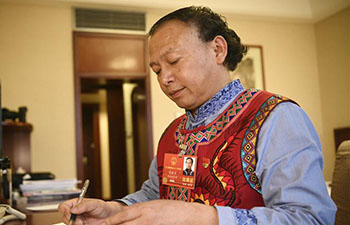by Xinhua writer Yuan Quan
BEIJING, March 18 (Xinhua) -- They are dilapidated buildings in villages of northern China's Shanxi Province: sites of no apparent interest.
But to Tang Dahua, 48, a cultural heritage lover, they are "dying friends," and he wants more people to know and save them.
His photos tell their own stories: an aging temple becomes a sheepfold surrounded by piles of goat dung; an ancestral hall is overgrown with weeds; a centuries-old wooden pagoda rots away; a theatre abandoned for decades collapses; archaic frescoes of a damaged temple are heavily eroded.
Some are listed as the cultural relics at county level, but some are even unknown to locals. Tang posted these dying buildings on social media, saying they were precious relics worthy of preservation and that "they will perish in the wild."
"In front of these buildings, you will feel the smallness of humans and the cruelty of time. You think something should be done," Tang said.
Tang has photographed the cultural relics for 12 years. He usually spends half a year seeking, researching and taking photos of damaged pagodas, temples, and any other historic sites in rural areas of Shanxi, home to 452 cultural relics under state-level protection and more than 28,000 ancient architectural sites -- among the highest in all provincial regions.
Since 2006, he has crossed hills and rivers, braved freezing cold and extreme heat, driving hundreds of kilometers from his hometown Shandong Province to Shanxi.
He has visited and recorded more than 400 long-neglected historic sites. The project he launched on Weibo social network "Snapshot and Save Historic Sites" has unveiled more than 200 ancient buildings on the verge of collapse. Tang says most information is provided by travelers, amateur cyclists and local villagers. "They have one thing in common: seeing these dying buildings as cultural relics."
An Internet entrepreneur, Tang started the project in 2011, after he posted a series of photos of a wooden temple built more than 110 years ago. "The dilapidated images and its long history created a sharp conflict that shocked the public," said Tang, who did not expect his photos to draw tens of thousands of hits and reposts within 24 hours.
The project has not only brought him 350,000 followers and considerable media coverage, but also with a hope that more cultural relics can survive.
The most successful case Tang remembers is an decaying temple "Longtian," which he found in 2014 in Xilianghe Village, 16 kilometers away from the Pingyao County, a world heritage site by the United Nations Educational, Scientific and Cultural Organization (UNESCO) in 1997.
The temple, almost collapsed, had rotted with only a few of wooden pillars left standing. Most frescoes inside, dating back to the Qing Dynasty, suffered from erosion due to rain and snow leaking through its dilapidated roof. Locals could not tell when the temple was built and abandoned. Lacking money, they are unable to repair it.
Tang posted the pictures of the temple on Weibo, and it soon drew attention from hundreds of web users and a dozens of media outlets, including the People's Daily, which published the pictures Tang photographed and called for people to protect cultural relics nearby.
Two months later, the local cultural relics bureau replied through its official Weibo account that restoration was underway. Since then, the temple has been frequented by Tang and other historic architecture lovers to see whether conditions improved or not.
In November 2015, Tang got a text message from a local villager that the temple had been restored and reopened for opera plays.
"I was very happy." Tang said. "The rural historic sites have regained the respect and popularity."
"Many historic sites are important because they are the platforms to display and protect intangible cultural heritage, such as operas, temple fairs and ancient crafts. Once the historic buildings are saved, the culture will be revived," he said.
More than 40 sites have been restored by the local governments after Tang posted the pictures. He has revisited some places many times to follow the restoration progress.
Tang found another threat that many historic buildings are facing - they are not officially recognized as cultural relics. Now that the province is rich in well-preserved heritage, some people or real estate developers dismantled, relocated and took away parts of unprotected buildings, attempting to sell them for more money, without official approval.
"I hope my constant exposure of these crimes will arouse government attention to intensify the preservation efforts," Tang said.
"I am touched by his passion. Hope more people join to take care of the neglected historic sites. They also record the nation's memory," said a web user with a screen name "Jiandan".
Tang calls himself "Aiguta" online, which means "love pagoda." His love for pagodas dates back to 30 years ago when he read a book introducing Chinese pagodas, while at high school. But now, his love has expanded to more buildings.
He also organizes rural relic tours guiding young people to "learn and respect the historic sites beyond the textbooks." As long as Tang is around, the future of China's neglected buidings looks bright.

















